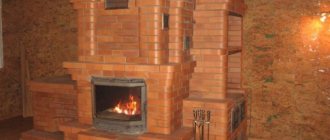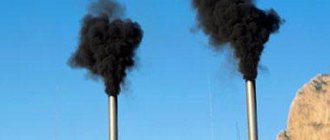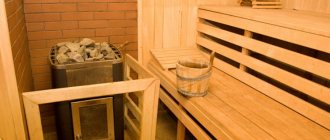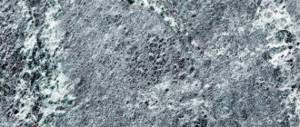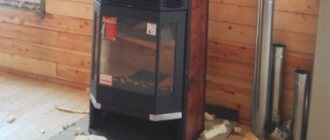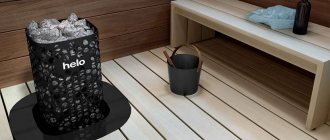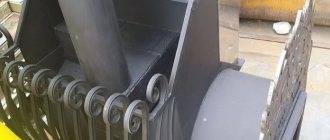Varieties of heat-resistant materials to protect walls from heat
Based on the type of raw materials that are used for the manufacture of heat-resistant materials, they are divided into:
- Materials with organic details, such as polystyrene foam boards. The fire resistance rating is not high enough, so it is used to protect against slight heat.
- Materials with inorganic components are used to insulate both wooden walls and concrete and brick walls. The following fire-resistant materials are used: stone wool, basalt slabs, fiberglass, fiber cement boards, polypropylene, honeycomb plastics, vermiculite panels, foamed perlite.
- Mixed materials include asbestos cardboard, asbestos-lime and silica refractories.
Most private houses are made of wood, be it a cylinder or frame house. Accordingly, in winter, in severe frosts, it is difficult without a stove or fireplace, so users approach the arrangement of such units responsibly and choose a heat-resistant material as the lining, which:
- will be effective and reliable protection against any fire;
- environmentally friendly, during the heating process it will not emit any harmful substances.
Protective screens
Protective fireproof screens are special fire-resistant decorative panels designed to insulate the side walls of furnace structures; they are mounted at a distance of 1-5 cm from the furnace body. The screen differs from a fire-resistant sheet in its multi-layer structure.
By using such heat-resistant insulation material, you can significantly reduce thermal radiation. Screens made of cast iron and stainless steel are widely popular.
The polished mirror surface of the steel screen reflects heat, which is characterized by softer flows. The plates located inside the screen are connected using heat-resistant mastic, mortar adhesive, and sealant, which are characterized by high heat resistance.
Heat-resistant mastic has a fire-resistant composition that can withstand high temperatures - 1100°C or more. In addition, it is not afraid of moisture, has bactericidal properties, and can be used as a cladding.
On the market you can find not only side screens, but also front ones. Installation of such devices is carried out by attaching them to the floor near the stove; the screen itself is equipped with special legs. In addition to steel and cast iron screens, quite often users also give preference to brick structures that look like walls. They separate the furnace body from flammable areas.
Protective screen
What is needed to weld a furnace
The main thing is to have the desire and the slightest skills, and then it’s a matter of technique:
- Welding machine
- Metal cutting tools
- Metal sheets or something like a cylinder, barrel, or any other metal container
- Pipe
In order for the stove to have the correct shape and work as expected, you need to weld the legs to it, cut out the door and holes for the blower, and also a hole on top for the stove. Cut a small window at the back to weld a chimney pipe there. If the stove is wood-burning, then make a compartment below for drying the wood. The hearth can be made not only with wood and coal, but also with oil. To do this, you need a container with a hole for kindling. To light a fireplace, you need to insert a match wrapped in a cloth and moistened with kerosene into the hole.
You can build a household oven yourself; for this you can find materials, time, and skills. But modern high-temperature ovens are no longer possible to do on your own. Such furnaces are created for heat treatment of various materials. Maximum temperatures here reach 1600 degrees, and such furnaces are used in industry and at enterprises in various industries. (See also: Vacuum in the boiler furnace)
The temperature in the furnace is set depending on the purpose of creating such a fireplace. And there are an innumerable number of such goals. Many factors depend on what the temperature in the oven will be.
- The original purpose of the hearths
- Fuel used
- Traction
- Materials used in production or handcrafting
A solid fuel boiler stove is a multifunctional stove that combines:
- Furnace for space heating
- Cooking oven
- Baking oven
- Stylish look to give your kitchen a special look
The boiler is turned into an oven by a special steel tabletop located on top of the hearth, on which you can cook, boil, heat, steam and fry. The boiler is designed to fire solid fuel, that is, coal. The boiler doors are made of cast iron, on which designs, patterns, and ornaments can be easily and naturally embossed, giving a special look to the unit. The cabinet doors are made of fireproof metal – steel. At the bottom of the boiler there is a compartment for coal and firewood, which is very convenient. The design accessories that go with this cauldron are very impressive: a poker and a dustpan.
It's no secret that modern hearths can be made to order. This will provide an opportunity to come up with a stove that no one else will have. An individual stove, made according to a specific plan, taking into account all the desires down to the smallest details, will make even the most inattentive guests pay attention to itself. A custom oven may cost more, but it's worth it. Today, customizing stoves is no longer such a novelty as it was quite recently. Remembering the century before last, looking at photographs and turning to history, you can see that all the old Russian stoves were alike. And this did not spoil them at all. On the contrary, if there was a Russian stove in the hut, then it was the pride of the hostess. Now times have changed, and people want individuality. And fantasy develops more and more every day. (See also: Electric sauna stove)
Given such a huge variety of stoves, fireplaces and stoves today, the question arises: how to choose adhesive for hearths? In this matter, you need to be guided by the rule: the stronger, the better. After all, we are talking about a stove, and this unit is capable of heating up to high temperatures, and if you choose low-quality glue, as well as one that is not suitable for this type of construction, such as fireplaces, then the structure will gradually collapse, cracking and splitting.
The bricks will develop flaws and this will disrupt the tightness of the fireplace. And this is unacceptable, because air will escape from the fireplace and it will lose its heating function. In addition, the appearance of the fireplace will deteriorate and it will become dangerous for further use.
The glue must be heat-resistant. What other properties should be present in glue for stoves and fireplaces:
- Heat resistance up to 800 degrees
- Easy to apply and smooth onto surfaces
- No slumping on vertical surfaces
- It can be used to seal cracks in fireplaces, that is, suitable for repairing fireplaces
Do not apply glue to a heated surface, or work at low temperatures, below 5 degrees. (See also: Open-hearth furnace)
The tiles should be laid on the stove from bottom to top. This will prevent the tiles from settling when laying.
You must immediately use a level when laying each individual tile, otherwise the glue sets quickly, and then it will no longer be possible to level the slab. The principle of laying tiles is very responsible, as it does not allow any mistakes. However, any tile, even those installed in the bathroom, does not tolerate mistakes. The material is fragile and tends to crack and break.
Oven adhesive should not be used on plastered surfaces. Otherwise, it will not have its intended purpose. The glue must contain instructions for use, dilution and operation. After the work has been done, you need to heat the oven carefully, that is, first bring it to a low temperature, and then gradually increase it the next day. This will help the glue adapt and serve the hearth for a long time.
Fireproof gypsum boards
These materials can be used as the main cladding of walls around well-heated stoves. And porcelain tiles of any color can be used as decoration.
This fire-resistant sheet material is characterized by the following properties:
- fire resistance parameter - up to 30 minutes of fire resistance;
- it will not ignite for another hour, even after the fire appears;
- dimensions: 120*250*1.25 cm;
- on the front and back sides there is cardboard treated with gypsum, inside there are fiberglass threads, they are responsible for resisting fire;
- the ends of the sheets are covered with cardboard material, along them there is a joining chamfer;
- Fastening can be done either with glue or with self-tapping screws.
What types of heat treatment furnaces are there?
Nowadays in industry and manufacturing, as well as in medicine and laboratory research, equipment for heat treatment of various materials is widely used. Such lesions can reach high temperatures inside. They are made of fire-resistant materials in accordance with all quality standards and tested repeatedly before use.
Where heat treatment furnaces can be used:
- In metallurgy for melting metals
- In mechanical engineering
- In medicine
- In laboratories
- In research institutes
This is not a complete list of industries where such furnaces are used.
Fireproof mineralite slabs
This material is characterized by high heat resistance and is made only from environmentally friendly substances:
- white/gray cement - up to 90% of the total material;
- mineral fibrous materials;
- Fibers reinforcing the slabs - give the slabs durability and strength.
The composition does not contain asbestos fibers, making these fire-resistant high-temperature boards suitable for home ovens. The slabs are quickly mounted on the wall using screws to the wall itself. To ensure higher reliability of the structure, you can install two sheets of minirite.
When installing, you need to leave a small distance, because When heated, the material may expand slightly.
Wall finishing with fire-resistant mineralite slabs
Protective wall coverings
To provide thermal protection for the walls of the bathhouse, special linings made of fire-resistant materials are provided. They prevent overheating of surfaces and reduce the likelihood of a fire in the room.
Important!
The height of the casing must exceed the height of the walls of the heating structure by 120 cm. The distance between the walls of the bathhouse and the casing is at least 3 cm. To ensure air convection, technological gaps are provided at the top and bottom of the casing.
Reflective trims
This option for protecting bath walls consists of metal sheets and a heat-resistant layer of thermal insulation. First, a heat-insulating layer is attached, and a sheet of metal with a polished surface is mounted on top of it.
It is non-combustible insulation that ensures effective reflection of thermal energy from wooden surfaces, reducing their heating.
Important!
The sheet reflector produces a softer heat that is easily perceived by the human body.
The following is used as a thermal insulation layer:
- Basalt wool. An environmentally friendly and safe material, characterized by high thermal insulation, hygroscopic and fire-resistant characteristics.
- Cardboard boards made of basalt fiber. A material characterized by good sound and heat insulation properties. In addition, it is resistant to fire and rotting.
- Asbestos cardboard boards. A material that is wear-resistant, impact-resistant and fire-resistant.
- Minerite panels. A popular fireproof material that provides structures with reliable protection from overheating and possible ignition.
To fasten such cladding, ceramic bushings that are resistant to heat are used. If there is a minimum safe distance from the walls of the bathhouse to the casing, a double layer of thermal insulation is installed.
Cladding with facing surface
If it is necessary to comply with the general style of the room, decorative finishing can be used for protective cladding.
The most common finishing materials for thermal sheathing:
- Terracotta (tiles). Wear-resistant material made from natural clay rock by firing. It is characterized by high wear resistance, durability, practicality and resistance to high temperatures. Terracotta is available matte and glazed.
- Clinker (tiles). The refractory material is made from clay and has a high density. Externally it resembles a brick for cladding.
- Tiles (tiles). A modern material, the front surface of which is represented by a textured pattern, ornament or texture.
- Soapstone chlorite. A pure rock that has a characteristic shade of gray or green. The material is characterized by impact resistance, wear resistance, heat resistance, durability and low hygroscopicity.
- Porcelain tiles. Impact-resistant and heat-resistant facing material. The textured surface of the tile allows you to imitate other natural materials - stone, wood, brick.
Installation of fire-resistant cladding in the steam room is carried out on a thermal insulation base using special heat-resistant solutions. The finished cladding has the following form: wooden surface – technological gap (3 cm) – fire-resistant base – facing tiles.
The following materials can be used as a fireproof base:
- Heat-resistant plasterboard panels with the addition of fiberglass. They are resistant to deformation, damage and high temperatures.
- Glass-magnesium panels based on glass fibers and a magnesium component. They have sound and heat insulation characteristics, are resistant to rotting, high moisture and temperature changes.
- Boards based on cement and natural mineralite fiber. This base is resistant to fire, rotting and high moisture.
Any heat-resistant panels for walls must have a minimum technological gap to ensure ventilation and reduce the thermal effect on wooden surfaces. Practical cladding will allow you to decorate the walls of the steam room in the same style.
The manufacturing technology of a sauna stove places special demands on the equipment of all its departments, including the chimney. Its design is slightly different from the chimney system of a home stove. It should ensure long-term heat conservation and safety for steam room visitors. Before organizing a chimney in a bathhouse, it is worth knowing several important nuances.
The design of sauna stoves includes 2 types of chimneys:
- Indigenous. They are organized next to the stove, using a special pipe for connection, through which the smoke goes into the main channel. One chimney can be used for 2-3 stoves. The main thing is that its internal diameter has the appropriate parameters, and the pipes from each heating device are located at different heights;
- Systems with a mounted pipe are mounted directly on the stove pipe and discharged through the roof. This chimney option is the most common for sauna stoves.
Classification of chimneys according to installation location includes 2 types:
- External. Their main part is located on the street and fixed to the wall using a bracket. They are not particularly recommended for baths, as they quickly cool down, losing precious heat.
- Internal. These are vertical structures with good traction, located inside the building.
Depending on the material used, chimneys are:
- Brick. A traditional look, characterized by labor-intensive masonry and high requirements for compliance with all parameters. They have a lot of advantages: durability, fire safety, strength, good thermal insulation and heat accumulation. Disadvantages include the roughness and angularity of the inner surface on which soot deposits accumulate;
- A metal chimney is faster to install and costs less. It has a perfectly smooth surface, but weaker heat-retaining characteristics;
- A combined version, including 2 parts: the lower one is made of brick, the upper one is made of a modern sandwich pipe. Allows you to organize neat, small passages that are easier to cover with heat-resistant material.
Protective stainless steel sheets
This material is not cheap, but it is very reliable. Using it, you can protect not only the walls of the house, but also the basement when installing a solid fuel heating unit.
In order to protect yourself and create maximum protection, special fiberglass with thermal protective properties is placed under the stainless steel. Such a design will cope well with the function of protection against the slightest attempt at fire. The choice of substrate should be approached very carefully; you need to thoroughly inspect the product for the presence of phenolic resins, which release harmful substances when heated strongly.
Fireclay fireproof boards
These materials include brick and mortar. Thanks to them, you can build a protective fireproof screen around the firebox and the body of the metal stove itself. The key difference between a brick screen and a lined one is that the liner is a protective casing that is installed flush against the walls of the structure.
Fireclay can withstand temperatures up to 1300°C. Currently, in addition to bricks and mortar, there is also fireclay coating, mastic, and glue, which can even be used during the operation of a stove or fireplace. They contain microscopic fireclay fibers and binding agents. They carry out lining of both the entire surface of the furnace and sealing of individual cracks. In addition, kaolin materials are produced for lining: paper, cardboard, cotton wool.
Fireclay fireproof boards
What materials are chimneys made from?
Brick pipe
Such chimneys are equally suitable for stone and metal stoves. For the main masonry, refractory bricks and clay-based mortar or a special “kiln mixture” are used. In the upper rows, facing materials and cement mortar are used.
Basic elements of a brick chimney
The smoke channel is plastered from the inside to close the seams and smooth out the planes - less soot and condensation will accumulate, and the draft will be better. The pipe configuration itself is no different; there are standard elements:
- riser,
- fluff,
- otter,
- neck,
- head,
- cap (deflector).
The main advantage of this solution is durability and high fire safety. However, a massive stone pipe needs time to warm up for stable traction.
Important! A brick chimney for metal stoves is not always a good option. It will not be possible to build it above the heat generator, so the channel is assembled nearby, the masonry is laid from the floor (foundation), and then the stove is connected to it with a horizontal transition.
Metal pipe
Steel chimneys are relatively lightweight, can be installed on top of a heat source, and are therefore well suited for factory-made heaters. The cross-section is selected depending on the power of the furnace; you need to follow the manufacturer’s recommendations or focus on the diameter of the outlet pipe. Most often, chimneys for bathhouse stoves require a cross-section of 115 mm.
Water pipes made of ordinary ferrous metal can only be taken with a large wall thickness (from 5 mm), but they can still fail at any time (they burn out from high temperatures and rust from high humidity). Galvanized products also do not shine with durability, since the protective layer wears off very quickly.
Design and connection options for a sandwich channel
The only decent option is stainless steel. In principle, you can use a single pipe, well insulating it in the attic and outside, but a sandwich will perform better. These are complete chimneys consisting of small sections. A home craftsman can assemble a sandwich channel on his own. Each element consists of two pipes of different sections, between which there is a thermal insulation filling. The line includes: a starting “single-wall” pipe for heat dissipation (sometimes with a water tank), main moldings about 1 meter long, transitions and bends, pass-through units for floors and roofing, inserts with dampers, top nozzles, deflectors.
When choosing a model for a sauna stove, you need to consider the following points:
- The wall thickness of the inner pipe should be maximum (from 0.8-1 mm),
- The grade of stainless steel must be resistant to temperatures of about 850 degrees, for example AISI 321 or AISI 439 and 409.
- The optimal thickness of basalt filling is from 50 mm (ideally 100 mm), and its density is from 120 kg/m3.
- We give preference to models with an outer pipe also made of stainless steel.
Important! The joints of metal pipes are positioned so that they do not fall into the cutting area and are visible.
Design of a heat-resistant double-circuit pipe for a bath
Ceramic chimneys
Ceramic chimneys can withstand heat and are not afraid of moisture. They are a prefabricated multilayer structure, which provides everything necessary: main linear blocks, inspection elements, containers for collecting and removing condensate (installed at the very bottom), cover plates, tees, ventilation grilles, upper mesh nozzles, etc.
Depending on the design, there are two types of products:
- Monolithic, self-supporting blocks, completely ready for masonry, with a through channel of circular cross-section. Between the inner cylindrical element and the outer flat casing there are bulkheads (stiffening ribs); they form chambers that play the role of a heat-insulating air layer and vertical ventilation ducts.
- Modular systems in which expanded clay concrete blocks perform the load-bearing functions, and smoke is discharged through a ceramic pipe located inside such a shaft. The block is placed on a cement-containing mortar, and the pipe from individual sections is assembled using sealant. Mineral wool is used to wrap a ceramic pipe like a sleeve.
Kit for making a ceramic chimney
Stoves and ceramic chimneys for baths are connected using a monopipe made of heat-resistant stainless steel. It is connected to the shaft from below or from the side. The installation diagram is selected depending on the technical conditions. The relatively light weight of the finished shaft allows for a mounted installation, although it is necessary to use support consoles or a brick base vault. If desired (for example, to free up space in the steam room), the root scheme can be implemented without any problems - the chimney is taken out into the dressing room or outside. To finish the chimney, use any suitable material (paint, flat stone, tile), having previously covered the blocks with cement slabs.
When choosing a chimney for your heater, do not forget that it will work in extreme conditions. Systems for conventional boilers and fireplaces cannot be used in this case. It is important to know and follow the installation technology, so it is advisable to invite experienced craftsmen to assemble the pipe.
